- News
- Reviews
- Bikes
- Accessories
- Accessories - misc
- Computer mounts
- Bags
- Bar ends
- Bike bags & cases
- Bottle cages
- Bottles
- Cameras
- Car racks
- Child seats
- Computers
- Glasses
- GPS units
- Helmets
- Lights - front
- Lights - rear
- Lights - sets
- Locks
- Mirrors
- Mudguards
- Racks
- Pumps & CO2 inflators
- Puncture kits
- Reflectives
- Smart watches
- Stands and racks
- Trailers
- Clothing
- Components
- Bar tape & grips
- Bottom brackets
- Brake & gear cables
- Brake & STI levers
- Brake pads & spares
- Brakes
- Cassettes & freewheels
- Chains
- Chainsets & chainrings
- Derailleurs - front
- Derailleurs - rear
- Forks
- Gear levers & shifters
- Groupsets
- Handlebars & extensions
- Headsets
- Hubs
- Inner tubes
- Pedals
- Quick releases & skewers
- Saddles
- Seatposts
- Stems
- Wheels
- Tyres
- Health, fitness and nutrition
- Tools and workshop
- Miscellaneous
- Tubeless valves
- Buyers Guides
- Features
- Forum
- Recommends
- Podcast
TECH NEWS
 Velocite Syn 02
Velocite Syn 02Velocite reveals new Syn aero road bike
Velocite are showing a new Syn aero road bike at Taipei Cycle, created after extensive CFD (computational fluid dynamics) and 3D surfacing work.
Victor Major, Velocite’s main man and the designer of the Syn, says that the bike is all about performance with aesthetic considerations not even a small part of the mix.
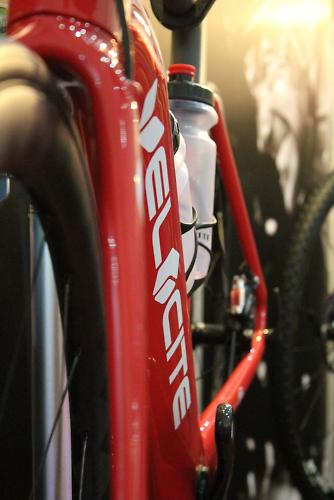
The down tube is 68mm across, the same as the bottom bracket, and it is shaped for aerodynamics. Look at the bike from head on and you can just see the sides of a (74mm diameter) water bottle extending out from either side of the down tube.

The idea is that the water bottle is integrated into the airfoil; rather than being shielded by that mighty down tube, it works with it to manage the aerodynamics. In order to do this, the rear of the down tube has been scooped out so that the bottle cages are recessed into the frame.
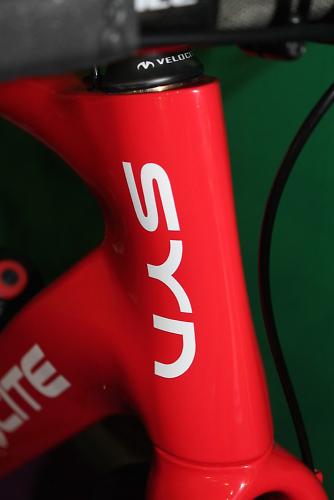
Velocite say that the head tube has been optimised for laminar airflow and all the other frame elements have similarly been designed for aerodynamics and stiffness. Comfort comes courtesy of a slim 27.2mm diameter seatpost.

As you can see, this Syn is fitted with disc brakes and this is the version that’ll go on sale first, probably in about three months. A rim brake model will follow.
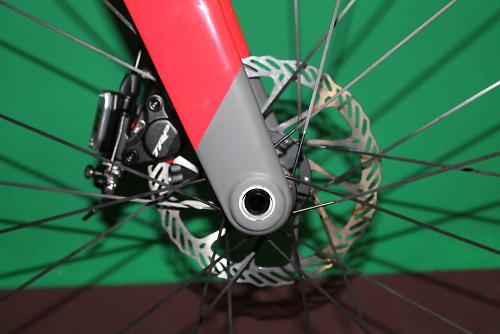
Velocite promise aggressive pricing for the Syn, comparable to that of the Giant Propel or the Cannondale Synapse.

The other new bike from Velocite is the Tor. These pics don’t do it justice but that’s shows for you. Velocite say it’s suitable for ‘dirt, road, whatever’. You can use it to race cyclocross if you like.

It’s made from unidirectional high modulus blend carbon fibre composite and comes with a tapered head tube (1 1/8in at the top, 1 1/2in at the bottom). You get clearance for 42mm tyres.
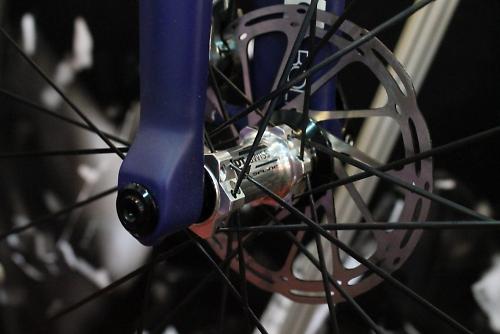
The Tor is available for disc brakes only, coming with a 12 x 142mm rear axle and a 15 x 100mm front axle.

Velocite have also very recently developed new wheel technology – or, rather, they’ve introduced existing technology into the wheel market for the first time with their Venn brand.
Unlike other wheels out there, the Venn Rev 35 wheels use a filament winding technique. Huh? Velocite explain it like this: “In filament winding, a continuous tow of fibres is passed through a bath of resin and wound onto a revolving mandrel by traversing longitudinally along the axis of the rotating mandrel.

“This results in optimal, continuous fibre placement under tension, the benefits of which are higher manufacturing uniformity, better performance and greater durability.”
Velocite say that most of the major wheel manufacturers have been interested in the technique which is used for manufacturing tubular components in the aerospace industry, for example.
It’s an automated process that doesn’t rely on people laying up carbon fibre correctly, and there’s no chance of any crimping.
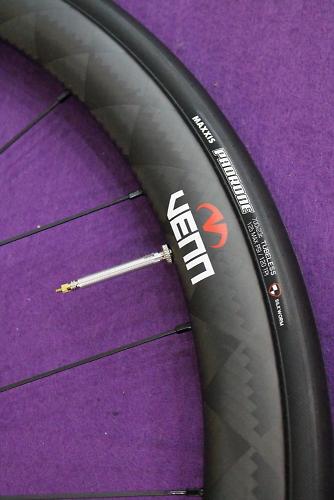
Velocite say that there’s 8.6% variability in the lateral stiffness of standard handmade wheels and 4.5% variability in the radial stiffness. With filament winding technology they say those figures are down to 3.5% and 1.6% respectively. In other words, they claim that there’s significantly greater uniformity in the manufacturing process.
The rims of the Venn Rev 35 wheels are 35mm deep and 28mm wide. They’re available for clinchers (with tubeless compatibility), both rim and disc brake versions, and as tubulars.
Another interesting wheel from the range is the cyclocross-specific Venn Alter. This one doesn’t use the filament winding technique but continuous tangent layup (CT technology instead.
technology instead.
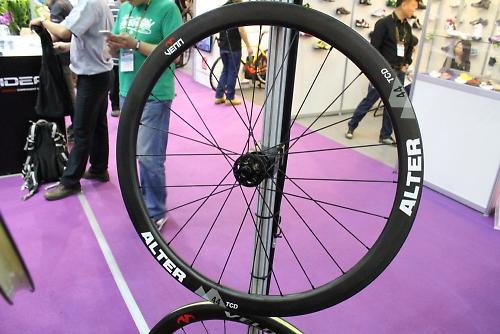
Rather than using individual segments of prepreg carbon fibre to make the rim, Velocite say that they lay it up using a special tool and process to achieve a single-piece toroidal shape. How do they do that? It’s a secret. And what’s the benefit?
“Each preform follows a continuous tangential relationship to the rim’s circumference thus ensuring that the forces acting on the rim are always evenly distributed across all the plies and individual carbon fibres,” according to Velocite.
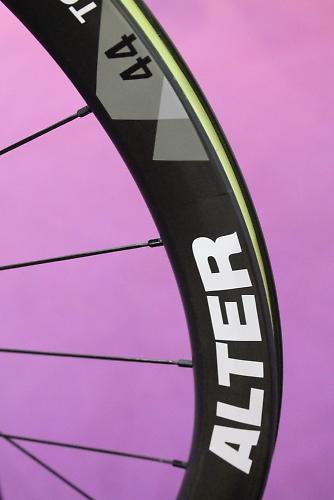
Velocite have abandoned aerodynamics with the Alter rim; they don’t see the point when a large cyclocross tyre is going to be fitted. Instead, they’ve gone for flat walls and a high strength 44mm deep x 26mm wide profile. It’s available in both disc brake and clincher (tubeless compatible) versions.
Mat has been in cycling media since 1996, on titles including BikeRadar, Total Bike, Total Mountain Bike, What Mountain Bike and Mountain Biking UK, and he has been editor of 220 Triathlon and Cycling Plus. Mat has been road.cc technical editor for over a decade, testing bikes, fettling the latest kit, and trying out the most up-to-the-minute clothing. He has won his category in Ironman UK 70.3 and finished on the podium in both marathons he has run. Mat is a Cambridge graduate who did a post-grad in magazine journalism, and he is a winner of the Cycling Media Award for Specialist Online Writer. Now over 50, he's riding road and gravel bikes most days for fun and fitness rather than training for competitions.
Latest Comments
- chrisonabike 5 min 41 sec ago
I mean - if you let their tyres down that's compromising their safety - attempted murder....
- mdavidford 6 min 22 sec ago
Not sure they're going about that the right way - how did that get them awarded gold?
- qwerty360 14 min 52 sec ago
Except there is legislation re what PSPO's can be used for....
- rct 22 min 2 sec ago
Local residents? It's in the middle of a massive industrial zone. What would cause carnage would be if the oil terminal next door blew up... ...
- brooksby 38 min 44 sec ago
No concerns were raised because it would likely cause no problems if a motor vehicle drove over it
- Gareth W-R 44 min 6 sec ago
I had one of these years ago, emx 5 was just under the top tier emx 7. This was a pro tour frame, used by boonen from what I remember along with the 7
- RoubaixCube 1 hour 15 min ago
I bought an offbrand plastic one for £14 that came with the go pro mount underneath. Prior to that I also had an off brand plastic one that was...
- rhodzilla 1 hour 33 min ago
Yeah, I've looked at a few others but they seem a bit complicated - what I like about this game is that the team selection is straightforward and...
- stonojnr 1 hour 43 min ago
People willingly drive up kerbs that are 15-20cm high, they don't care about what speed bumps might do to their vehicles at speed, even before half...
- antonae 2 hours 2 min ago
My experience is the same as Rostrider, in the line of what Matt insinuates about the Zero Road grip on wet conditions: a fatal disaster, hard to...
Add new comment
5 comments
The Syn is up there with The Defy for ugliness.
There's more PSMB in that article than I've seen in a long time; it stands for pseudo-scientific marketing bollocks, but I can't reveal how it's made...
I don't get why they've put disk brakes on an all out aero bike?
Surely rim brakes hidden away would make more sense?
Whoever is riding the Velocite might want the next frame size up
That Syn is as ugly as sin